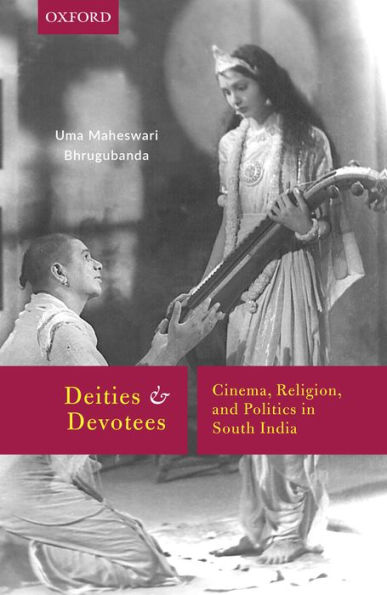Deities and Devotees: Cinema, Religion, and Politics in South India
How have cinema and popular religion shaped each other? Is the display of devotion in a cinema hall the same as devotion in a temple? How do we understand cinema’s compelling power to mesmerize people? Unlike Hindi cinema, mythological and devotional films remained popular genres in Telugu (and Tamil too) until quite recently. The political success of film star N.T. Rama Rao, well-known for his portrayal of gods and kings, posed afresh the problem of cinema’s power to enthral. To what extent viewers were persuaded of his divinity became a matter of debate. In later decades, the figure of another kind of viewer haunted the discourses around cinema, that of the female viewer who got possessed during screenings of goddess films. Using questions around viewership as the focal point, this book studies the intersections between popular cinema, religion, and politics in South India. The first full-length study of Telugu mythological and devotional films, it combines an account of the history and politics of these genres with an anthropology of film-making and viewership practices. It argues that cinema and other audio-visual technologies lead to the re-orientation of sensibilities and the cultivation of new sensory modes.
1130560454
Deities and Devotees: Cinema, Religion, and Politics in South India
How have cinema and popular religion shaped each other? Is the display of devotion in a cinema hall the same as devotion in a temple? How do we understand cinema’s compelling power to mesmerize people? Unlike Hindi cinema, mythological and devotional films remained popular genres in Telugu (and Tamil too) until quite recently. The political success of film star N.T. Rama Rao, well-known for his portrayal of gods and kings, posed afresh the problem of cinema’s power to enthral. To what extent viewers were persuaded of his divinity became a matter of debate. In later decades, the figure of another kind of viewer haunted the discourses around cinema, that of the female viewer who got possessed during screenings of goddess films. Using questions around viewership as the focal point, this book studies the intersections between popular cinema, religion, and politics in South India. The first full-length study of Telugu mythological and devotional films, it combines an account of the history and politics of these genres with an anthropology of film-making and viewership practices. It argues that cinema and other audio-visual technologies lead to the re-orientation of sensibilities and the cultivation of new sensory modes.
89.99
In Stock
5
1

Deities and Devotees: Cinema, Religion, and Politics in South India
268
Deities and Devotees: Cinema, Religion, and Politics in South India
268
89.99
In Stock

Product Details
| ISBN-13: | 9780199093274 |
|---|---|
| Publisher: | OUP India |
| Publication date: | 09/18/2018 |
| Sold by: | Barnes & Noble |
| Format: | eBook |
| Pages: | 268 |
| File size: | 7 MB |
About the Author
From the B&N Reads Blog
